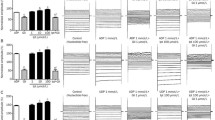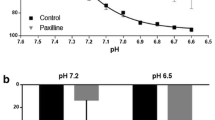Abstract
The effect of activators of protein kinase A on membrane K+ permeability and the interaction of these compounds with cromakalim, an opener of ATP-sensitive K+ channels (KATP channels), were investigated. Membrane K+ permeability was assessed by measuring 86Rb+ efflux from rings of rat aorta. Forskolin, an activator of adenylate cyclase, and isobutylmethylxanthine (IBMX), a nonselective phosphodiesterase inhibitor, induced small, concentration-dependent increases in tracer efflux up to 20-40% over the basal level. The effect of forskolin was abolished by the K+ channel blocker tedisamil (1 µM) and partially inhibited by glibenclamide (1 µM), a relatively selective blocker of KATP channels. Further studies were conducted in the presence of 35mM KCl in the bath in order to increase the size of the 86Rb+ efflux stimulated by forskolin and IBMX. At high concentrations, these compounds produced a biphasic effect with a peak increase being followed by a lower plateau value. Glibenclamide inhibited the 86Rb+ efflux response to forskolin and IBMX by 50-80%. The K+ channel blockers tedisamil (1 µM), Ba2+ (1mM) and tetraethylammonium (10mM) also reduced the peak response to forskolin by about 50% and abolished or greatly inhibited the plateau response. In addition to the small effect on basal 86Rb+ efflux, forskolin (0.3 µM) increased cromakalim-induced 86Rb+ efflux 3.4 times. At higher concentrations, however, a concentration-dependent inhibition was observed with an IC50 value of 7.6 ±0.4 µM. 1,9-dideoxyforskolin, which does not increase cAMP, increased neither basal nor cromakalim-induced 86Rb+ efflux; however, it inhibited cromakalim-stimulated tracer efflux with an IC50 value of 22 ±2 µM. It is concluded that forskolin and IBMX, probably by increasing intracellular cAMP levels, induce a 86Rb+ efflux from rat aorta, the major part of which is glibenclamide-sensitive and may pass through KATP channels. In addition, low concentrations of forskolin greatly facilitate the KATP channel opening effect of cromakalim whereas high concentrations block the channel; this blocking effect of forskolin is unrelated to the cAMP elevating action.
Similar content being viewed by others
Author information
Authors and Affiliations
Additional information
Received: 25 September 1996 / Accepted: 20 December 1996
Rights and permissions
About this article
Cite this article
Kessler, C., Löffler, C., Linde, C. et al. Activators of protein kinase A induce a glibenclamide-sensitive 86Rb+ efflux in rat isolated aorta. Naunyn-Schmiedeberg's Arch Pharmacol 355, 483–490 (1997). https://doi.org/10.1007/PL00004973
Issue Date:
DOI: https://doi.org/10.1007/PL00004973




